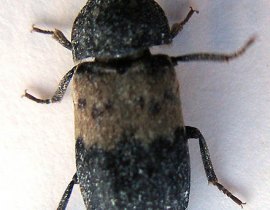Professional Pest Control & Wildlife Management
Larder Beetle
The Larder Beetle Dermestes lardarius is a relatively large black beetle with an off-white band accross its centre with six black dots. They fall somewhere between being a stored product and a textile pest eating just about anything which was from organic origins. As it names infers it is a common pest of dried foods and also can be found on furs and animal hides.
-
Risks
Larder beetles are not known for spreading diseases, the only risks they pose is the contamination of food stuffs and larvae damage to leather and materials of natural sources.
-
Treatment
Treatment should begin with a survey to hopefully discover the source of the infestation. A good residual spray treatment paying particular attention to areas of beetle activity should remove the problem in one attempt.
-
Life Cycle
Adult Larder beetles lay their eggs on or near a suitable food source. When the eggs hatch about two weeks later the dark and hairy larve begin feeding, like similar species the larder beetle larvae are known as 'Wolly bears'. From egg to adulthood takes around three months and adulthood lasts about the same.
- False Widow Spider Removal
- Cluster Fly help
- The trouble with fleas?
- Mole Catching in Suffolk
- Rats in the Garden
- Wasp Nest Control
- Rats in your chicken Coop
- Anaphylaxis
- Bee Swarms
- Becoming a Beekeeper
- Rare Breed Poultry
- Pest Control with Birds of Prey
- Un-marked vehicles available
- Rabbiting with Ferrets
- Myxomatosis
- Poll-Tex Mesh
- Honorary Member Russell Wallis
- Free Rabbit Control


